Wood Pellet Cat Litter Review: We Tried Horse Bedding Cat Litter
Last Updated on
We tried using wood pellet horse bedding as cat litter. And it might just be the cheapest effective option out there.
Just because something isn’t labeled “cat litter” doesn’t mean it isn’t.
As cat guardians, we’re happy commercially produced cat litter was invented- the wide range of options available to us is awesome. Litter manufacturers are continually innovating and improving their products. New litters claiming more effective odor control, a lighter formula, and eco-friendly sourcing are ceaselessly introduced to the consumer. But what if we’re overlooking an excellent litter option which isn’t labeled for cats at all? Let’s put aside the well-polished scientifically developed formulas for a minute and take a closer look at this effective and viable litter solution: wood pellet horse bedding. Think Feline Pine™ litter without the markup that comes with the cat litter label.
Disclaimer: We have not used Feline Pine™, and make no claim that it is exactly the same as wood pellet bedding.
I’m all over any innovations in the cat world. If there’s something we can do better for our cats, you’ll find me at the front of the line straining to learn more about it. For the past month at Wildernesscat we’ve gone a little cat litter crazy- researching litter brands, trying to figure out if there’s a “best cat litter” out there, and what that would require.
We’ve got several key criteria for the ideal cat litter.
- Safe for cats. Most litters have a downside, but we don’t want something blatantly dangerous.
- The cats like it. A litter is worthless if the cats refuse to use it, so this is a big one.
- Effective odor control. Cats are awesome, but that “cat pee smell” isn’t.
- Low tracking. Who wants bits of litter all over their house? Ew.
- Dust-free. Not only does that cloud of clay dust make you choke, but it can also be a dangerous carcinogen.
- Low maintenance. How much time does it take to keep the litter box clean? Our time is valuable to us.
- Affordable/cost-effective. Hey—who wants to spend a lot of money on what’s essentially their cat’s toilet water? I’d rather buy freeze-dried cat treats and snazzy cat-venture equipment, personally.
How does wood pellet bedding stack up?
What is wood pellet bedding, and is it safe for cats?
Wood pellets are made from compressed wood shavings. These wood shavings are sourced from excess wood, a byproduct of the lumber industry. You’ll be happy to hear that there is no strip mining involved! Wood pellets make a renewably sourced, eco-friendly litter. As a bonus, wood pellets are also biodegradable.
When packaged as horse bedding, some manufacturers don’t detail the wood that has gone into the pellets, simply labeling it as “softwood pellets” (pine, cedar, fir, larch, redwood, etc.).
Though rare, we have heard reports of cats negatively reacting to pine or cedar based litters. Pine and cedar contain plicatic acid within its resin. This acid acts as an irritant, and exposure to pine or cedar dust can irritate your cat’s respiratory system. If your cat has asthma, pine or cedar based litter may exacerbate symptoms.
While this doesn’t seem to be a popular issue, you should be aware that the risk exists. Unfortunately, clumping clay litters are no safer. They are often dustier and send silica dust (a known carcinogen) into the air you and your cat breathe.
What did the cats think? 
Enter our critic: Wessie. Wessie regularly has two litter boxes adjacent to one another, both filled with clumping clay litter. For most of his life he’s used the same litter, or a similarly textured clumping clay.
One of the biggest complaints about the wood pellets is their large size and hard texture, so I was curious to see what Wessie would think of this drastically different litter. He’s not a picky cat but generally does prefer a fine, sandy texture to do his business in. I dumped out the old clay litter from one of the boxes and filled it with fresh wood pellets. The pellets weren’t particularly consistent in length, they ranged from approximately 1/4”-1”. 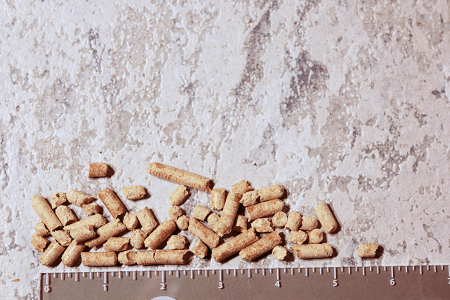
Wessie still had the option to use his clay litter, and for the first day, I don’t think the pellets were used at all. After a couple of days, I noticed the wood pellets had absorbed some liquid waste and there was light sawdust accumulation. When I actually saw him using the box, I noticed he didn’t enjoy digging in the pellets and preferred to cover his waste by tossing over the clay from the adjacent box.
Wessie continued to use the clay litter for solid waste until we eventually switched both boxes over to the wood pellet litter and he had no other option. Overall, he wasn’t a fan of the new texture but he could live with it. I believe that if we stuck with the pellets, he’d adjust well to them.
If your cat is particularly selective about their litter, I recommend a slow transition and an open mind to rejection. Even if your heart is set on wood pellet litter, your cat just might not like it.
Does it have good odor control?
Wood pellets smell great coming out of the bag.
The odor control was impressive. Usually, there’s a lingering urine odor around the litter box, which has always been a frustrating but accepted part of the cat experience. As long as we scoop, we’re good, right? The wood pellets soaked the urine right up and almost completely absorbed the odor. I could only smell a light piney scent, and I didn’t want to get any closer to try and smell anymore. The litter did a decent job with solid waste as well.
We tested the absorbency and odor control of the pellets with a urine simulation (ammonia and water blend). The pellets instantly soaked up the liquid and expanded into sawdust. The pellets neutralized the ammonia odor within a few seconds.

Does it track all over the house?
Some of the litter did end up outside of the box, possibly due to excess flourish in the litter box. There wasn’t a big difference from the usual clay litter. A few of the smaller, broken up wood pellets did get tracked a few feet away from the box, but nothing extreme- the pellets are too big to get stuck in between kitty toes. Wessie has a short coat, so he’s never had an issue with litter getting stuck in his fur. However, even longer haired cats haven’t reported many problems with wood pellet litter.
Is it dust-free?
I didn’t see (or taste) any dust while pouring the wood pellet litter into the box. It was a pleasant change from the dangerous, almost invisible cloud of clay dust we’ve come to expect even from the so-called 99% dust-free clay litters. As the litter breaks down into fluffy sawdust, there’s a higher chance that wood particles will become airborne during the scooping process, however, I didn’t notice anything. My lungs were happy with the wood pellets.
Is the litter easy to maintain?
The wood pellets quickly absorb moisture and disintegrate into sawdust. If you shake the litter, the sawdust naturally filters down to the bottom of the box, leaving unused pellets at the top. Solid waste is easily separated and scooped out of the litter. Unfortunately, since the pellets don’t clump moisture, you’re left with a pile of sawdust gradually taking over the box. This means that you’ll be dumping out the entire contents of the litter box after only a couple of weeks, rather than once a month as you would with a clumping clay litter. This means you’re going to be wasting some of the unused pellets.
One solution pellet litter users have found is the implementation of a sifting litter box system. In a sifting litter box, the fine sawdust will filter through a screen in the bottom of the box to a level below, which you can easily dump out daily, resulting in almost no wasted pellets. If I were to switch over to the pellets full time, this is the route I would take.
This Frisco sifting litter box has a 4.5 out of 5-star rating on Chewy.com and has great reviews from wood pellet litter users.
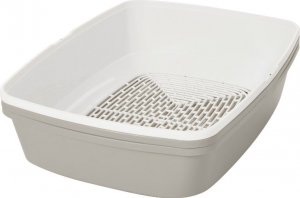
Another option is sifting through the pellets every day using a hand litter scooper and shaking the sawdust into the trash. Maybe if litter scooping is your favorite hobby, but I can’t see that working out for the majority of us who already have busy lives.
How much does it cost?
If you’re looking for an affordable cat litter, wood bedding litter is an amazing option. It’s important to note that we use litter by volume, not by weight. Wood pellets are lighter by volume than a clay litter, so the customary 40lb bag of wood pellet bedding is going to go further than the same sized container of clay litter. I purchased a 40lb bag of wood pellet bedding from our feed store for $6.99. That’s $0.17/lb vs. the $0.50/lb we usually spend on our litter.
You should be able to find several options at your local equine, feed, or hardware store. In-store shopping seems to be a better bet for horse bedding pellets—the lowest price for this 40 lb bag of pellets by American Wood Fibers is $24.66.
That same product is available for in-store pickup at Walmart and Ace Hardware for $6-$8.00.

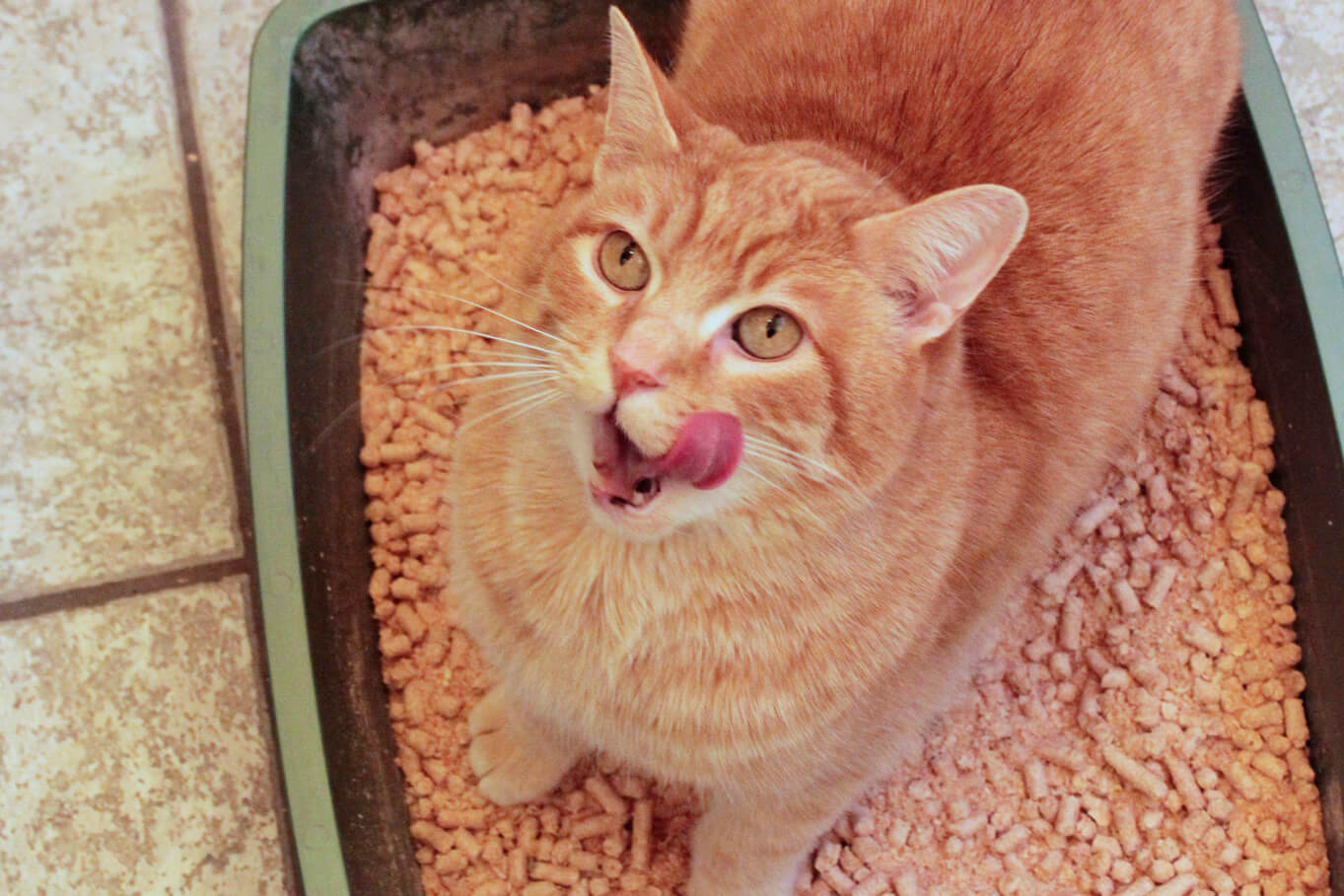

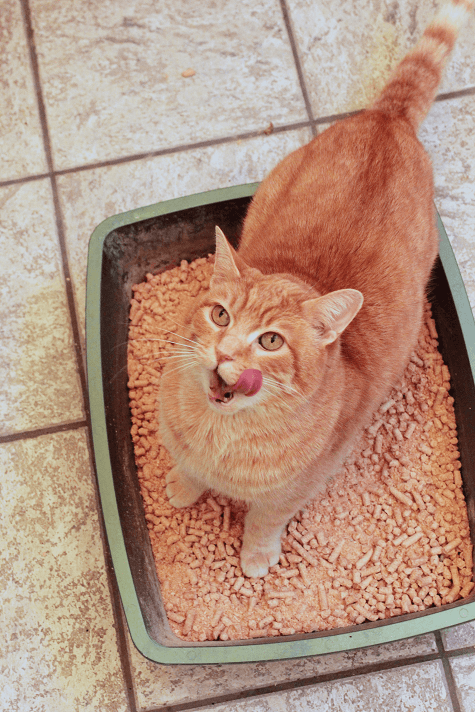

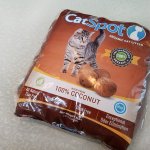

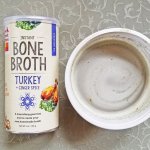


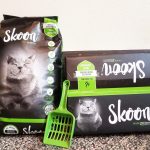
I use something similar for cat litter but it is not compressed into pellets. I was told about it by a personal support worker that came to see my mother. She had a few cats and used it for cat litter. I live in a rural area in Ontario Canada and I get it from Home Hardware in the farm section. It is shrink-wrapped in plastic in the shape of a bale of hay and is called wood shavings. It shows it being used in horse stalls and for small animals like chickens and rabbits. It comes in fine shavings or medium shavings now. I used to get something else similar that is not available anymore so they told me to get the fine shavings but I’m wondering if I should have got the medium shavings because what I have is almost like sawdust. The only thing with it you have to be careful of is it is so compressed in the shrink wrap that when you open it it expands so much that I have filled two 65 litre plastic totes and I still had quite a bit left over. I scrunched up the top of the bag to close it off and put the whole thing inside a clear blue recycling bag so no moisture would get in it. It only cost me about $7.50 for the package. Not only is it a lot cheaper then the clumping cat litter but it weighs next to nothing when I clean the litter box and take it to the garbage. I have severe carpal tunnel and it was getting to the point that I could not carry the bottles or boxes of the clumping cat litter. One of these packages of wood shavings lasts me close to a year. My cat started using it right away and there is only a bit of it that comes out of the box if he starts scratching too hard. Some Home Hardware stores do not have it so you’d have to check to see if it was available in your area but I strongly recommend it if you can get it.
Stove pellets From your Lowes, Home Depot or similar are cheaper (And The same) as the wood pellets marketed as horse bedding.
i am thinking about using equine pine bedding as littler but then i just came across this article. not sure it’s worth the risk – https://articulateanimals.com/blog/2009/10/essential-oils-pine/
My cat is wheezy (hasn’t been diagnosed with asthma but probably has it) all the time so I don’t think I’ll try the pine or cedar. Do you think other tree pellets are okay for wheezy kitties?
Are you concerned that your cat may be allergic to pine or cedar? Although it’s made from sawdust, the litter wasn’t very dusty and I do think that other types of wood pellets might work well for your wheezy kitty.
My wife and I have been using the bedding from Tractor Supply. I did modifications on existing litter boxes. The pellets become powder and drop through a grate onto a disposable sheet. The result is a system that allows us to empty the box about every two weeks. Feces are removed with a scoop designed to let the pellets fall through. At this point we have not had to do a total, thorough cleaning of the system. We are thinking of manufacturing the system if we determine there is enough interest.
Nice! It sounds a little bit like the Tidy Cats Breeze system.
I actually horse, and was just wondering today if I should try this for my cat! I did a google search and here you are! Thank you!
ApproveSent via the Samsung Galaxy S8, an AT&T 4G LTE smartphone ——– Original message ——–From: Disqus Date: 11/5/18 8:34 AM (GMT-07:00) To: [email protected] Subject: Re: Comment on Wood Pellet Cat Litter Review: We Tried Horse Bedding as Litter “I actually horse, and was just wondering today if I should try this for my cat! I did a google search and here you are! Thank you!”
Settings
A new comment was posted on Wildernesscat
Tracy Harvill
I actually horse, and was just wondering today if I should try this for my cat! I did a google search and here you are! Thank you!
10:34 a.m., Monday Nov. 5
|
Other comments by Tracy Harvill
Reply
to Tracy Harvill
Moderate this comment by email
Email address:
t****@home4tracy.com
|
IP address: ***.***.***.53
Reply to this email with “Delete”, “Approve”, or “Spam”,
or moderate from the Disqus moderation panel.
You’re receiving this message because you’re signed up to receive notifications about activity on threads authored by wildernesscat.
You can unsubscribe
from emails about activity on threads authored by wildernesscat
by replying to this email with “unsubscribe”
or reduce the rate with which these emails are sent by
adjusting your notification settings.